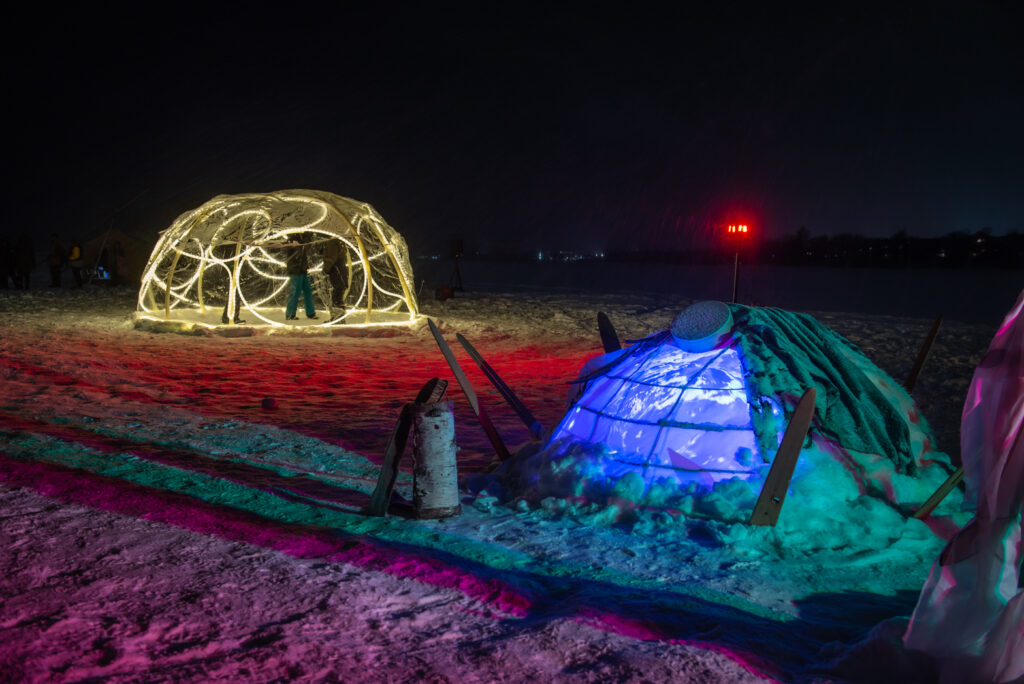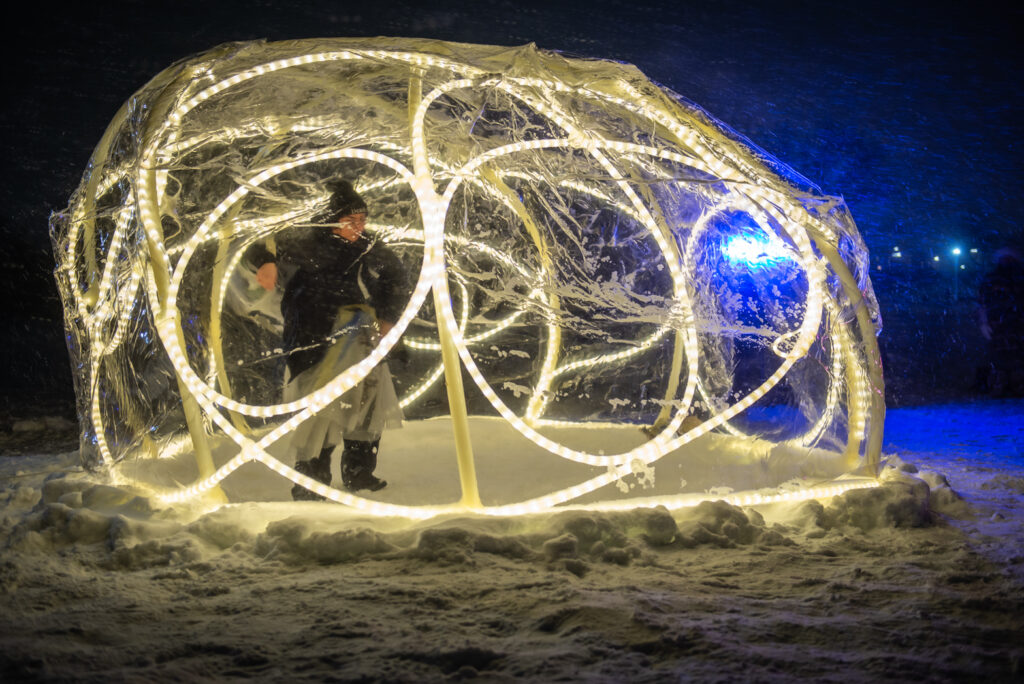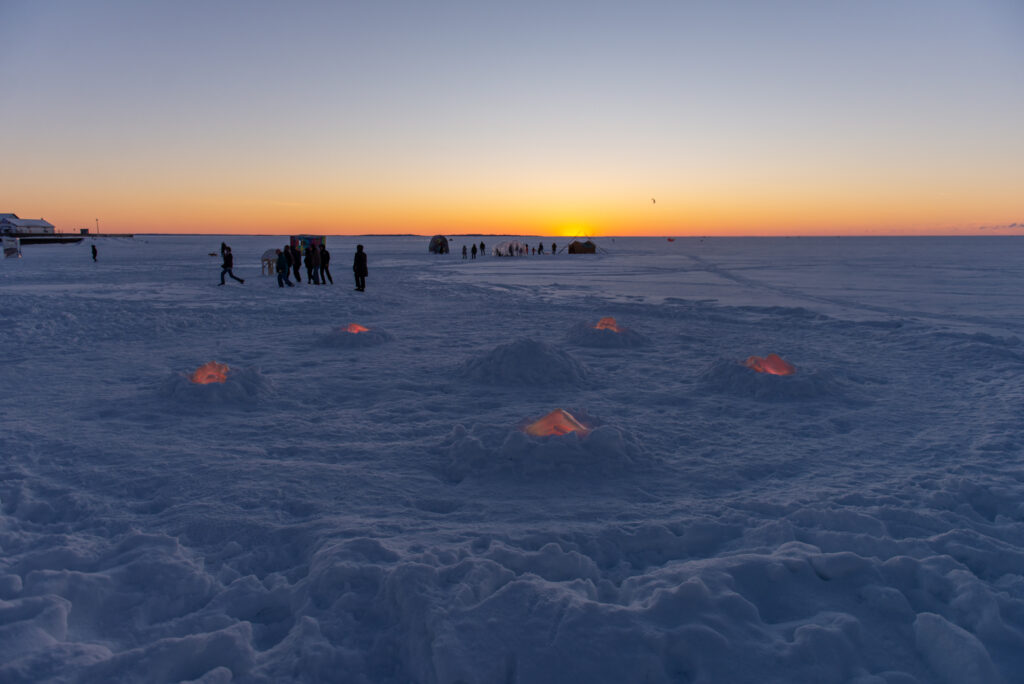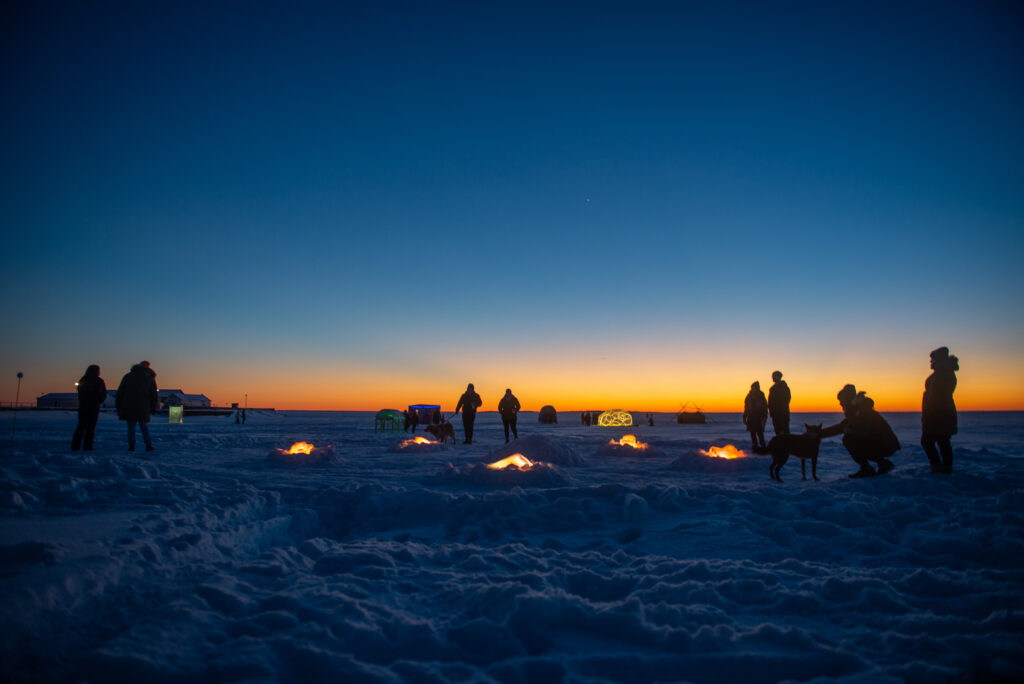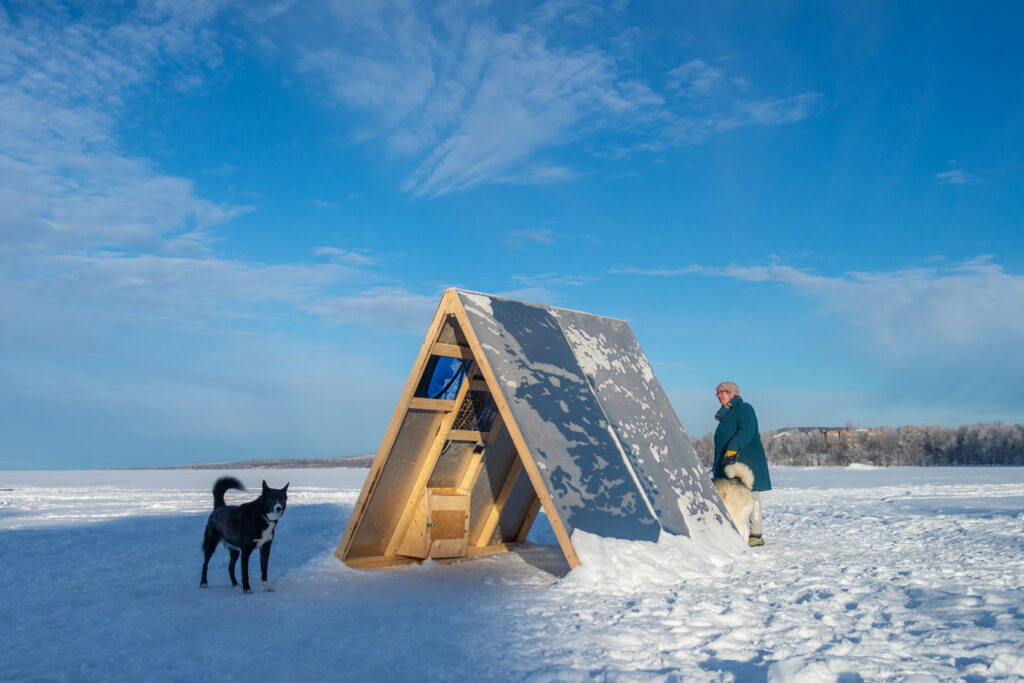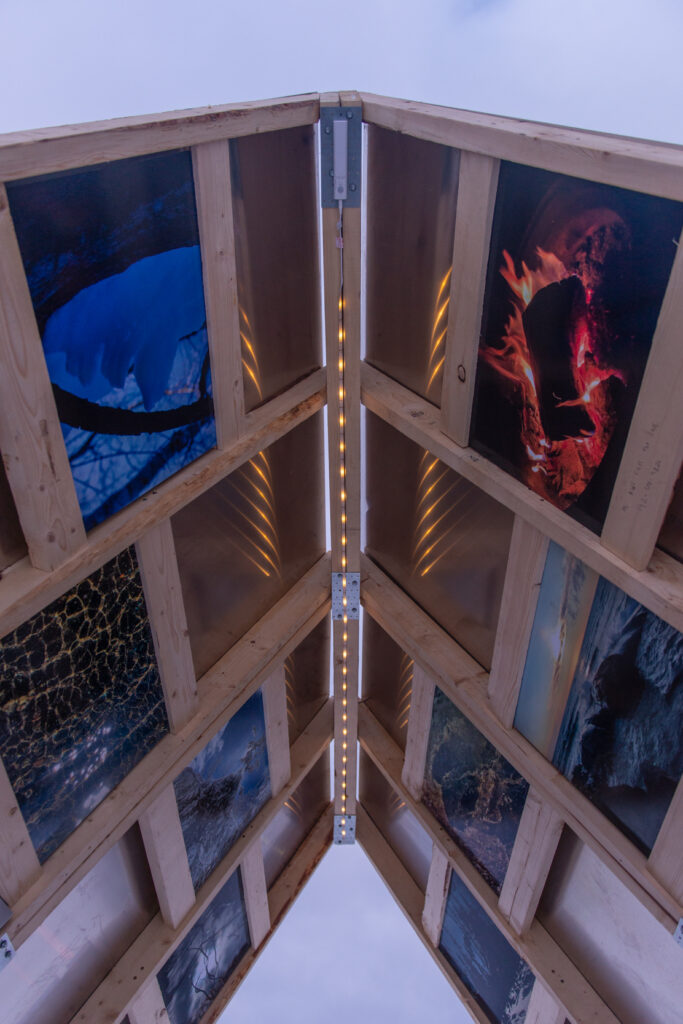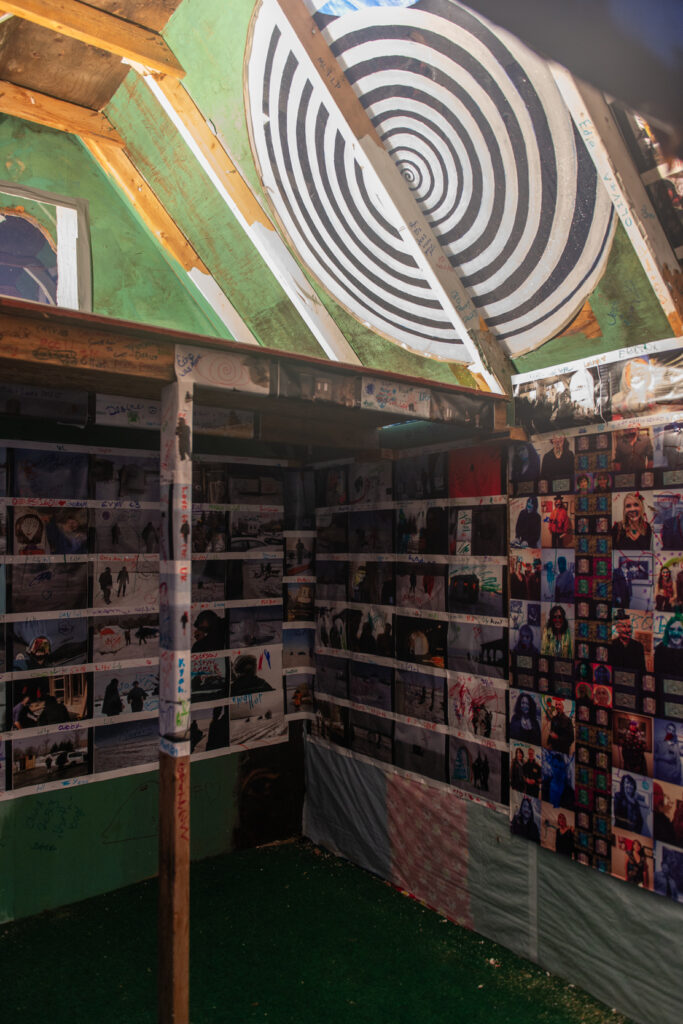Ice Follies
North Bay
February 10 – 24, 2023
A short review of things past is in order, here: the biennial exhibition Ice Follies began in 2004, when Dermot Wilson, then the director and curator of the WKP Kennedy Gallery in North Bay, decided to move beyond the parameters of the gallery’s white box, and address the surrounding geography: the fact that the city of North Bay sits adjacent to the large, shallow body of water that is Lake Nipissing, a favourite spot for fishers in search of pike, pickerel and other species that inhabit its waters.
More specifically, Wilson wanted to explore the architecture of the ice (or fishing) shack, which the urge to fish in the lake during its frozen months has spawned (no pun intended). Throughout the winter months when the ice is thick enough to be safe, shacks dot the lake, in some places closely packed together to form what resembles small communities situated above sites where fish prefer to congregate. So, responses to this architecture was at the forefront of the first exhibition with contributions from the likes of Kim Adams, Susan Detwiler, Ernest Daetwyler, and Ivan Jurakic.
At the next iteration of the exhibition in 2006, response to the vernacular architecture of the ice shack began to wane ever so slightly, and participating artists either explored the specifics of the site more directly (eg. Peter van Tiesenhausen’s snow mound far out onto the ice into which he had dug a hole big enough for one person to crawl into and meditatively look out upon a horizon uninterrupted by the sights and even sounds of the nearby cityscape), or perhaps more jarringly, utilized the site as a kind of set showcasing how, even here, technology intrudes. FASTWÜRMS reworked an ice shack as something akin to a film set for a fictional narrative, and Lise Beaudry reinvented an ice shack as a kind of miniature theatre where one could sit and watch a video loop based on her family’s experiences fishing out on the ice, the act, the technological depiction of the art, the process displacing the actual act, the process, here.
That’s kind of how we got here, to the 2023 incarnation of Ice Follies, thematically entitled “Thin Ice.” Certainly the participatory is key to it all, for we must obviously choose to come to this place, choose to be cold and wet as we walk out onto the ice, choose to trudge through snow and into the wind, choose to see and experience the work first-hand. But what we come to experience has become less first-hand in intention, for much of the work here diverts us away from itself and deeper into the technologies that absolutely comprise our everyday life. Perhaps inevitably, thingness has become less of a forefront issue, the ice shack structures, which might arguably be likened to products of an analog world have been rendered to the background of leading edge digital technologies. Ice Follies has become less of an exhibition of sculpture and the site-specific, and more a realm of QR codes and video projections.
Dr T’uy’t’tanat Cease Wyss’s A Visit to the Underwater World of Gichi-nibiinsing-zaag’igan is composed of a skeletal structure of metal and wood like a minimalist sculptural sketch of a canopy, having an apex from which a plastic tub containing a video projector is suspended. Aimed straight down, it projects onto the packed snow surface atop the lake ice, visually summoning imagistic interpretations of what might be happening with the life beneath the ice that we cannot otherwise witness.
By day, Quinn Hopkins’s Limited/Limitless resembles nothing more than a tall box the sides of which are mirrored surfaces, reflecting us back at ourselves. In the evening darkness, this becomes a light box, its interior a diorama comprising, in part, a stylized sculptural fish, gorgeously rendered. It’s a pickerel, depicted not as a stuffed and mounted trophy but as the living creature that makes its home in these waters. A QR code gives access to more of the world beneath the seasonal surface of ice (“tap on ground to spawn fish”). Hopkins defines his physically located work as a “target for AR [Augmented Reality] activation,” elucidating the secondary nature of thingness that seems to define much of what is showing here; technologically augmented layers of visual meaning supersede Hopkins’s physically situated work.
There is, of course, work here in which technology is secondarily in service to the physical artefacts of the site-specific. Andrew Ackerman and Chris Koslowski’s im·pulse (done in conjunction with Fine Arts Students at Nipissing University here in North Bay) is a case in point. The piece barely rises over the surface of the snow and is easily missed save for its illumination: glowing red spots spread out across the snow. Close up they resemble upheavals of the ice, thick chunks pushed up and seemingly incandescent as if suggesting immense heat rising from below. If there is a work here that most closely cleaves to the theme of “thin ice,” this is it.
As well, im·pulse rather constitutes the middle ground of Ice Follies, the fulcrum where technology is in balance with thingness, with sculptural artefact; the power lines that provide the work’s illumination are in service to the work, not the other way ‘round. So over on one side of this metaphorical fulcrum are the structures of Aanmitaagzi, five of them in a site-specific work that gives the exhibition its title Thin Ice, pieces ranging from something closely akin to a classic ice shack, to a structure of sheets of canvas painted and inscribed with text, all laid across a framework of arched branches, to a classic canvas tent, to a dome of transparent plastic (illuminated at night with rope lighting). And way over on the fulcrum’s other side is Imogen Clendenning’s work, Archive on Ice. It shucks loose the need for artefact – save for using Dermot Wilson’s work as a place upon which to mount a solar panel to power a raspberry pi server that hosts the work’s content – and is entirely a creature of the digital realm, purely a QR code providing access to an archive of previous iterations of Ice Follies. There is no ‘there’ there. Well, not entirely; both the darkness of night and a day of heavy cloud cover render the solar panel all but useless and bring the site down. Clendenning’s work clearly articulates interesting possibilities for the future of Ice Follies. Even here, at the virtual edge of things, place can still have still a say.
Gil McElroy is a poet, writer and artist. He is author of Gravity & Grace: Selected Writings on Contemporary Canadian Art (2001), Gaspereau Press, and five books of poetry.






